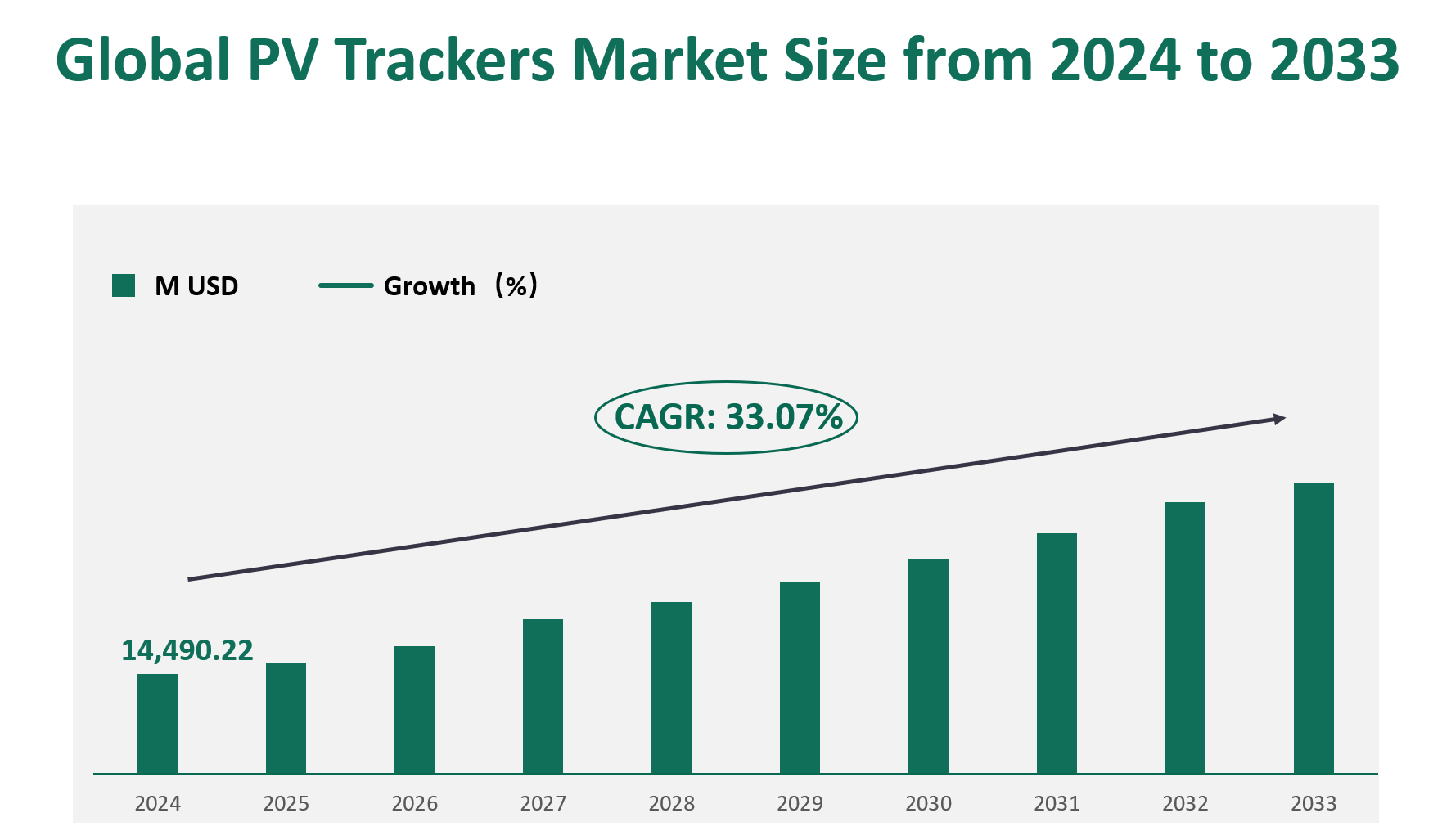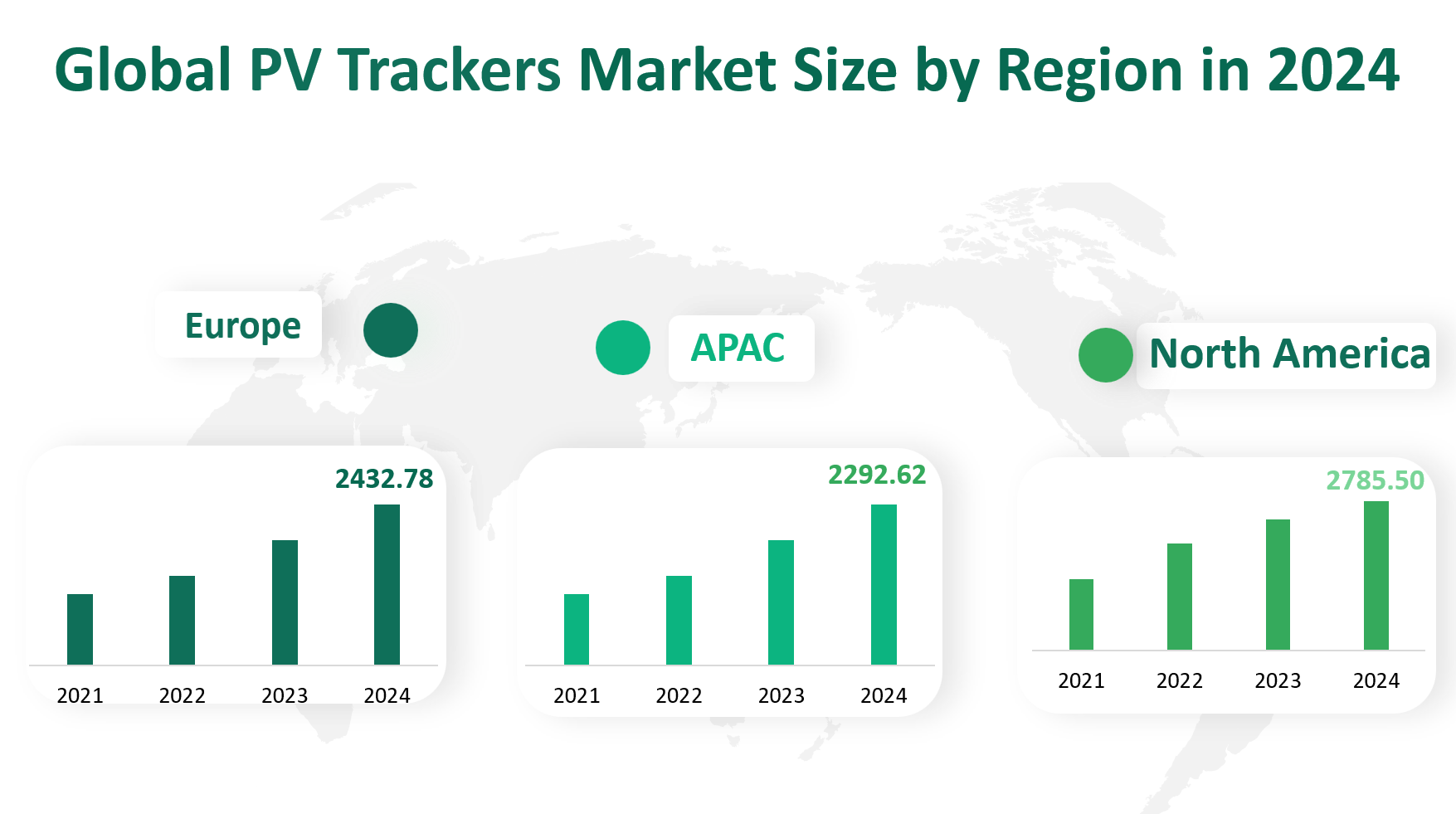1. Global PV Trackers Market Insight Analysis
The global PV Trackers market is projected to reach a revenue of $14,490.22 million USD in 2024, with a Compound Annual Growth Rate (CAGR) of 33.07% from 2024 to 2033.
PV Trackers are essential components in the solar energy sector, designed to optimize the efficiency of solar panels by adjusting their orientation to follow the sun’s movement throughout the day. This technology significantly enhances the energy output compared to fixed-tilt systems, making it a crucial solution for maximizing solar energy capture. The market for PV Trackers is segmented into two primary types: Single-Axis and Dual-Axis. Single-Axis trackers rotate on a single axis, moving back and forth in one direction, while Dual-Axis trackers move in two directions to continuously face the sun, offering even greater efficiency. The market also covers various applications, including residential, commercial, and utility-scale installations, with utilities holding the largest market share.
Figure Global PV Trackers Market Size (M USD) and CAGR (2024-2033)

2. Driving and Limiting Factors of PV Trackers Market Growth
The growth of the PV Trackers market is influenced by several key factors. One of the primary driving forces is the increasing global awareness and demand for renewable energy sources. Governments around the world are implementing policies and incentives to promote the adoption of solar energy, which directly benefits the PV Trackers market. For instance, countries like Germany, Italy, France, and Spain in Europe, as well as the United States, China, and Japan, have set ambitious renewable energy targets and provided subsidies to support the solar industry. These policies not only encourage the installation of solar panels but also drive the demand for advanced technologies like PV Trackers to enhance energy production.
Another significant driver is the technological advancements in the solar industry. The development of more efficient and cost-effective PV Tracker systems has made them more accessible and attractive to both residential and commercial users. Innovations such as improved motor systems, advanced control software, and better materials have reduced the overall cost and increased the reliability of PV Trackers, making them a viable option for a broader range of applications.
However, the market also faces certain limitations. One of the main challenges is the initial high cost of PV Tracker systems compared to fixed-tilt installations. The complexity of the technology and the need for moving parts result in higher upfront investment and maintenance costs. Additionally, the installation of PV Trackers requires more site preparation and infrastructure, which can be a barrier for some projects. Furthermore, the market is highly competitive, with a few major players dominating the industry. Companies like NEXTracker, Array Technologies, and Arctech Solar hold significant market shares, making it difficult for new entrants to establish a foothold.
3. Technology Innovation and Corporate Mergers and Acquisitions in PV Trackers Market
The PV Trackers market is characterized by continuous technological innovation and strategic corporate activities. Companies are constantly investing in research and development to improve the efficiency, durability, and cost-effectiveness of their products. For example, NEXTracker’s NX Horizon™ and NX Gemini™ trackers offer advanced data monitoring and control software, enhancing the overall performance of solar plants. Similarly, Array Technologies’ DuraTrack® HZ v3 is designed with fewer components and an innovative wind management system, making it more reliable and cost-effective.
Corporate mergers and acquisitions are also shaping the market landscape. Strategic partnerships and acquisitions allow companies to expand their market reach, acquire new technologies, and strengthen their competitive positions. For instance, the acquisition of NClave by Trina Solar in 2018 reinforced NClave’s position in the PV Tracker market and provided Trina Solar with advanced tracking solutions. Such strategic moves are expected to continue as companies seek to consolidate their market positions and enhance their product portfolios.
4. Global PV Trackers Market Size by Type
Photovoltaic (PV) trackers are essential components in solar energy systems, designed to optimize the efficiency of solar panels by adjusting their orientation to follow the sun’s movement throughout the day. The global PV trackers market is segmented into two primary product types: Single-Axis and Dual-Axis trackers.
Single-axis trackers rotate on a single axis, typically moving back and forth in a single direction. They are available in various configurations, including vertical, horizontal, tilted, and polar aligned. This type of tracker is designed to maximize solar energy capture by maintaining an optimal angle relative to the sun. The simplicity of their design often makes them more cost-effective and easier to maintain compared to dual-axis trackers.
In terms of market revenue, single-axis trackers have a significant presence. In 2024, the forecasted revenue for single-axis trackers is projected to be $11,252.77 million. This substantial revenue is attributed to their widespread use in utility-scale solar projects, where large arrays of solar panels benefit from the continuous adjustment provided by single-axis trackers. The market share of single-axis trackers is expected to be 77.66% in 2024, indicating their dominance in the PV trackers market.
Dual-axis trackers, on the other hand, offer a higher level of precision by moving in two different directions. They continuously face the sun, providing maximum energy capture throughout the day. This advanced functionality makes dual-axis trackers highly efficient, especially in regions with high solar irradiance. However, their complexity and higher cost can limit their adoption compared to single-axis trackers.
The forecasted revenue for dual-axis trackers in 2024 is $3,237.45 million, which is significantly lower than that of single-axis trackers. Their market share in 2024 is projected to be 22.34%.
Table Global PV Trackers Market Size by Type in 2024
5. Global PV Trackers Market Size by Application
The applications of PV trackers span across various sectors, each with distinct requirements and market dynamics. The primary applications include Residential, Commercial, and Utilities.
Residential applications of PV trackers involve the installation of solar panels on single-family or multi-family homes. These systems are designed to provide electricity for domestic use, reducing reliance on traditional power grids and lowering energy costs for homeowners. Residential PV trackers are typically smaller in scale compared to commercial and utility applications but offer significant benefits in terms of energy independence and cost savings. In 2024, the forecasted revenue for residential PV trackers is $323.74 million.
Commercial applications of PV trackers encompass a wide range of non-residential buildings, including restaurants, entertainment venues, commercial plazas, industrial buildings, and mining facilities. These installations are designed to meet the energy needs of businesses, reducing operational costs and enhancing sustainability efforts. Commercial PV trackers are typically larger in scale than residential systems but smaller than utility-scale installations. The forecasted revenue for commercial PV trackers in 2024 is $903.80 million.
Utilities applications represent the largest segment of the PV trackers market. These installations are designed to provide electricity to the public grid, often through large-scale solar farms. Utilities applications benefit significantly from the efficiency gains provided by PV trackers, as they can maximize energy capture and reduce the levelized cost of electricity (LCOE). In 2024, the forecasted revenue for utilities PV trackers is $13,262.68 million.
Table Global PV Trackers Market Size by Application in 2024
Application | Market Size (M USD) 2024 |
Residential | 323.74 |
Commercial | 903.80 |
Utilities | 13262.68 |
6. Global PV Trackers Market by Top Regions
North America is expected to be a significant contributor to the global PV trackers market revenue in 2024. The region’s strong emphasis on renewable energy, coupled with supportive government policies and incentives, has driven the adoption of PV trackers. The forecasted revenue for North America in 2024 is $2,785.50 million. This region is characterized by advanced technological capabilities and a high level of investment in solar infrastructure.
Europe is another key region in the PV trackers market, with a forecasted revenue of $2,432.78 million in 2024. European countries have been at the forefront of renewable energy adoption, driven by ambitious targets to reduce carbon emissions and increase the share of renewable energy in their power mix.
The Asia-Pacific region is projected to be the fastest-growing region in the PV trackers market, with a forecasted revenue of $2,292.62 million in 2024. This growth is driven by the increasing demand for renewable energy in countries like China, Japan, and India, which are investing heavily in solar infrastructure to meet their growing energy needs.
The Middle East and Africa region is expected to generate a revenue of $3,576.12 million in 2024. This region’s market growth is driven by the abundant solar resources and the increasing focus on renewable energy to meet the rising energy demands.
South America is forecasted to have a revenue of $3,403.20 million in 2024. The region’s market growth is driven by countries like Brazil and Argentina, which are actively promoting renewable energy to diversify their energy mix and reduce dependence on fossil fuels.
Figure Global PV Trackers Market Size by Region in 2024

7. Global PV Trackers Market Analysis by Major Players
7.1 NEXTracker
Company Introduction and Business Overview
NEXTracker is a leading provider of intelligent solar tracker solutions, offering advanced data monitoring and control software. Established in 2013 and headquartered in the USA, NEXTracker has a global business distribution. The company is known for its innovative and reliable solar tracking systems, which are designed to maximize energy output and improve the efficiency of solar power plants.
Products Offered
NEXTracker’s flagship products include the NX Horizon™ single-axis tracker and the NX Gemini™ dual-axis tracker. These trackers are designed to provide maximum flexibility and reliability, ensuring optimal energy capture in various site and weather conditions.
7.2 Array Technologies
Company Introduction and Business Overview
Array Technologies, Inc. is a prominent manufacturer of solar tracking systems, offering durable and reliable solutions for utility-scale and distributed generation projects. Established in 1989 and headquartered in the USA, Array Technologies has a global business distribution. The company is known for its innovative engineering approaches and high-quality products.
Products Offered
Array Technologies’ flagship product is the DuraTrack® HZ v3, a single-axis tracker designed for durability and reliability. The company’s trackers are known for their innovative use of fewer components and a failure-free wind management system, which reduces maintenance requirements and enhances overall performance.
7.3 PV Hardware
Company Introduction and Business Overview
PV Hardware (PVH) is a leading provider of solar tracking solutions, offering innovative products for the global utility-scale solar market. Established in 2011 and headquartered in Spain, PVH has a business distribution across Europe, the USA, Asia-Pacific, and the Middle East. The company is known for its high-quality products and commitment to customer satisfaction.
Products Offered
PVH’s flagship product is the Monoline 2V-60B single-axis tracker, designed to support 60 panels per row. The company’s trackers are known for their investment-grade quality and ability to drive down the levelized cost of energy (LCOE).

